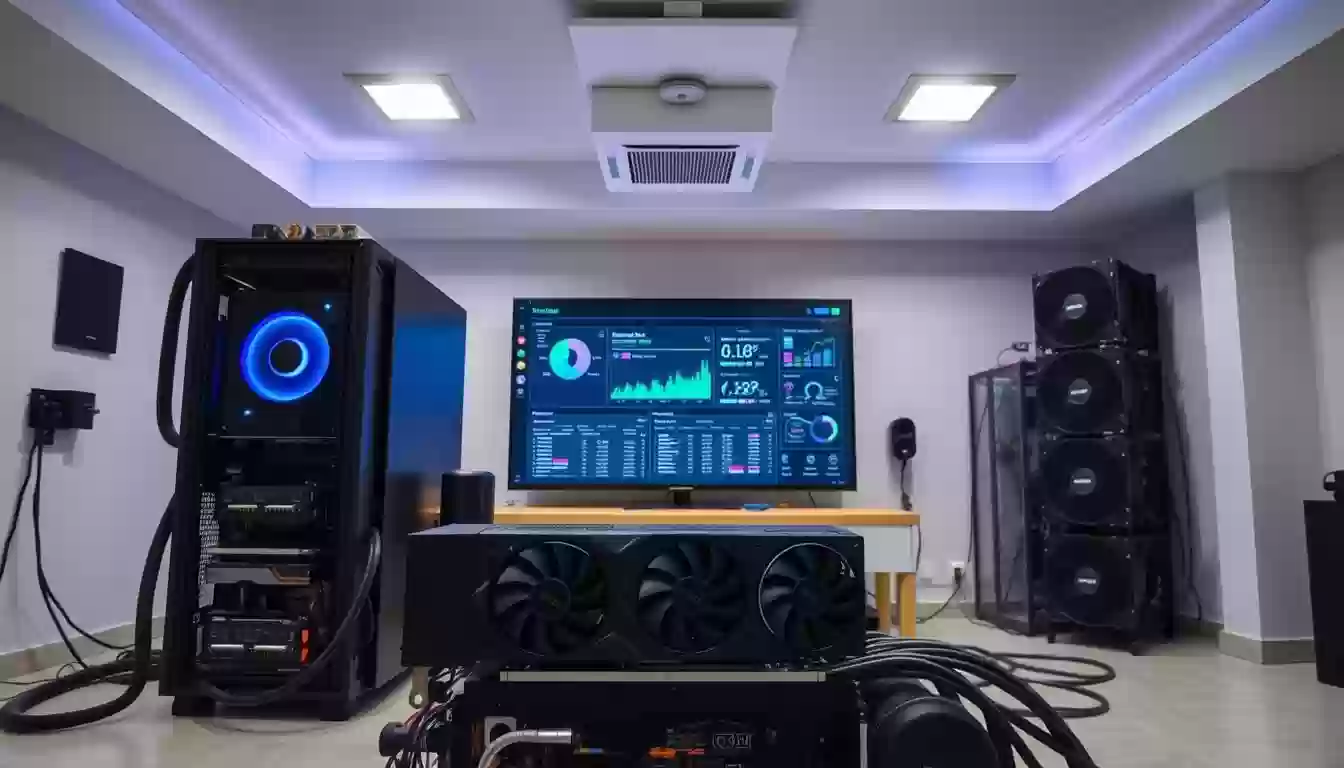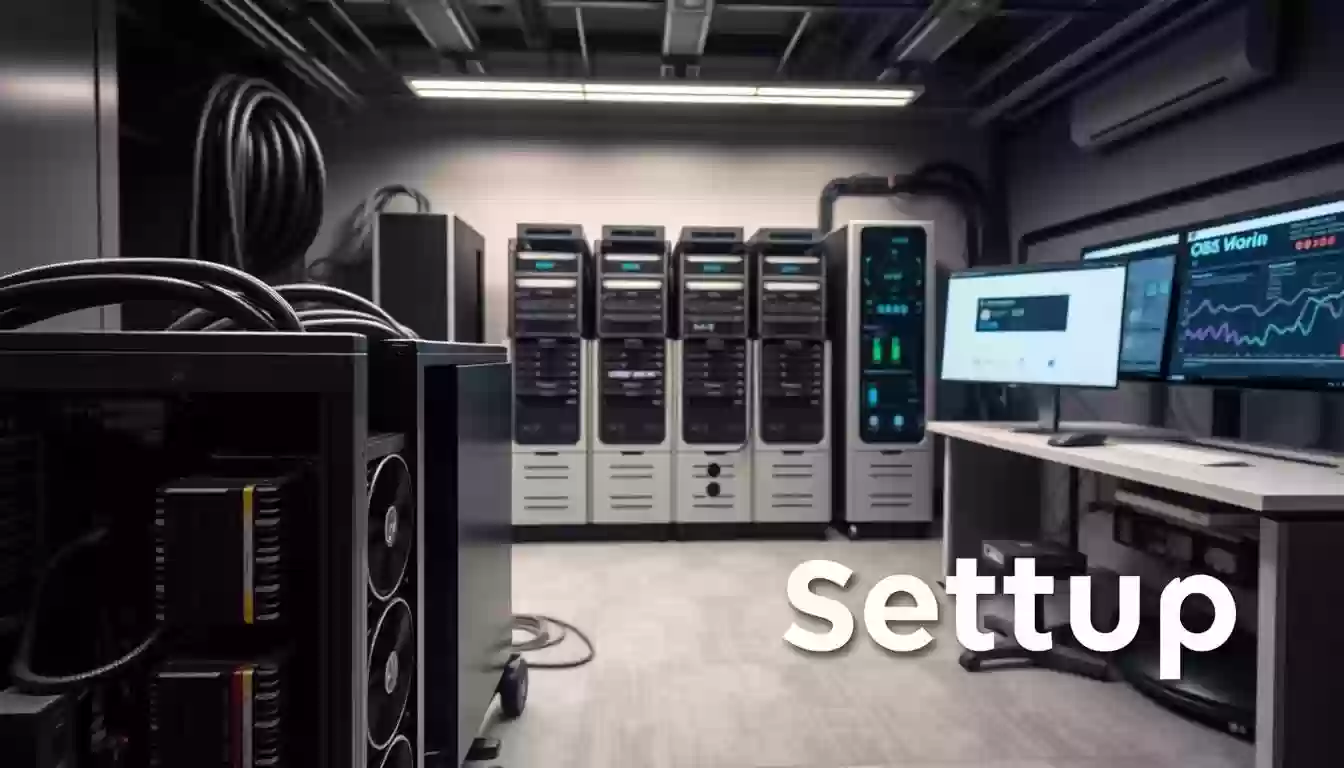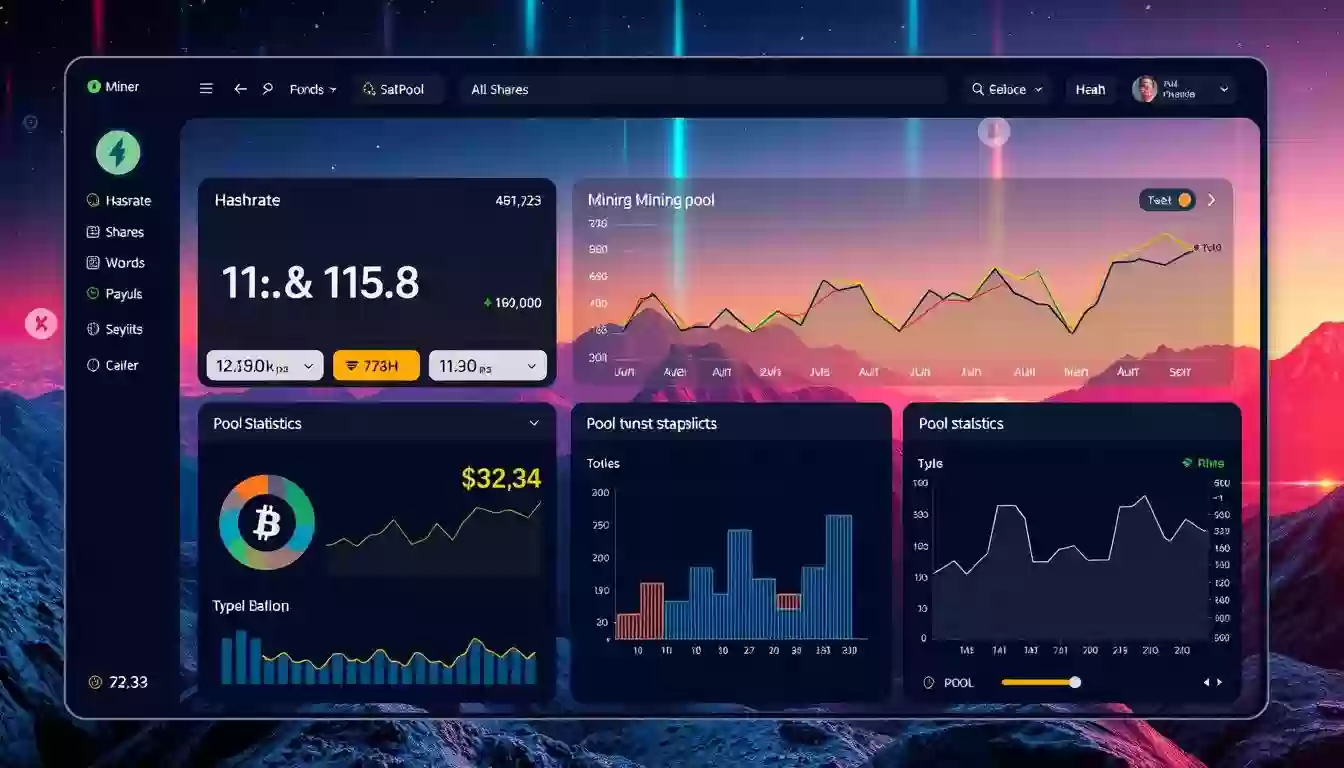Mining Pool Setup Tutorial: Easy Step-by-Step Guide
 07 Mar 25
07 Mar 25
Welcome to our comprehensive guide on setting up your own cryptocurrency mining pool. Whether you're a seasoned miner or just starting out, this tutorial will walk you through the process with clarity and precision. Our goal is to empower you with the knowledge to create a well-structured mining pool that maximizes efficiency and profitability.
Why is a mining pool important? A mining pool allows multiple miners to combine their computational power, increasing the chances of solving complex mathematical problems and earning rewards. By pooling resources, participants can share costs, reduce variability in income, and create a more stable revenue stream. This collaborative approach is particularly beneficial for smaller miners who might otherwise find it difficult to compete with large-scale operations.
What will you learn in this guide? We'll cover the essential components needed to set up a mining pool, including hardware, software, and security configurations. You'll gain insights from industry projects like PegaPool and ProPool, which have successfully implemented similar setups. Additionally, we'll discuss the importance of proper research and configuration to ensure your mining pool operates efficiently and securely.
By the end of this guide, you'll have a clear understanding of how to establish a mining pool that aligns with your goals, whether it's for revenue generation, community building, or brand visibility. Let's dive in and get started!
Introduction to Mining Pools and Their Benefits
Discover how collaborative efforts in cryptocurrency can enhance your success. Mining pools have become a cornerstone in the cryptocurrency ecosystem, offering numerous benefits to participants.
Understanding the Role of a Mining Pool
A mining pool is a collective network of users who combine their computational resources to solve complex mathematical problems. This collaboration significantly increases the likelihood of discovering a block and validating transactions on the blockchain.
By pooling resources, participants share both the workload and the rewards. This approach not only makes the process more efficient but also reduces the variability in income, providing a more stable revenue stream for everyone involved.
Advantages for Revenue, Community, and Brand Visibility
Joining a mining pool offers several advantages. Firstly, it increases revenue potential by providing consistent payouts. Secondly, it fosters a sense of community among participants, building trust and collaboration. Lastly, it enhances brand visibility, allowing participants to promote their brand on a larger scale.
| Advantage | Description | Benefit |
|---|---|---|
| Revenue Increase | Consistent payouts through shared resources | Stable income for participants |
| Community Building | Collaborative environment among miners | Improved trust and cooperation |
| Brand Visibility | Opportunity to promote one's brand | Enhanced market presence |
Examples like PegaPool and ProPool demonstrate how effective reward systems can benefit participants. These pools have implemented robust systems that ensure fair distribution of rewards, making them attractive to both new and experienced miners.
Mining Pool Setup Tutorial Essentials
Creating a mining pool requires careful planning and execution to ensure efficiency and security. A well-structured approach is crucial, especially for those new to this process. By following a step-by-step guide, you can avoid common pitfalls and set up your pool effectively.
Why Follow a Step-by-Step Guide?
A step-by-step guide is indispensable for several reasons. Firstly, it helps reduce errors by breaking down the process into manageable parts. This systematic approach ensures that each component is correctly configured, leading to a more efficient setup. Additionally, a clear guide makes troubleshooting easier and maintains consistency across installations.
Overview of the Complete Setup Process
The setup process involves several key stages:
- Planning: Define your goals and choose the right hardware and software.
- Configuration: Set up servers and network settings securely.
- Testing: Ensure everything works before launching the pool.
Secure account and password management is vital during this process. Using real-life examples, like Dockerized public-pool projects, can illustrate the benefits of detailed planning and testing. These examples show how careful preparation leads to a smooth and efficient service rollout.

By adhering to a methodical process, you can streamline your service and ensure a successful mining pool setup.
Key Infrastructure and Security Configurations
Building a reliable mining infrastructure requires careful attention to both hardware and software. A well-configured setup ensures efficiency, security, and optimal performance. Let’s explore the essential components and best practices for a robust infrastructure.
Hardware, Software, and Network Requirements
Hardware Selection: High-performance servers with multi-core processors are crucial for handling complex computations. Energy-efficient ASIC miners, like those used in Bitcoin mining, are preferred for their superior hash rates and lower power consumption. Ensure your hardware is compatible with your blockchain of choice.
Software Essentials: Choose a reliable operating system and node implementation. Bitcoin node setups often use Linux-based systems for stability. Dockerized deployments can simplify configuration and scalability, as seen in public-pool projects.
Network Stability: A high-speed, low-latency network is vital for real-time communication between servers. A stable connection ensures consistent performance and data accuracy.
Implementing Robust Security Measures
Firewalls and Encryption: Protect your network with firewalls and encrypt sensitive data. This deters unauthorized access and ensures data integrity.
Two-Factor Authentication: Enhance account security with 2FA to safeguard against breaches. Regular security audits help identify vulnerabilities early.
Server Security: Use secure protocols and keep software updated. Examples from Bitcoin node setups show how robust security can prevent common issues.
Step-by-Step Process for Configuring Your Mining Pool
Setting up a mining pool involves a series of strategic steps that require careful planning and execution. This process ensures your pool operates efficiently and securely, attracting miners and maintaining their trust.
Conducting Preliminary Research and Planning
Before diving into the technical aspects, it’s crucial to conduct thorough research. Understanding the target blockchain, assessing competition, and evaluating hardware and software requirements are essential. For instance, ProPool and PegaPool succeeded by meticulously planning their infrastructure and reward systems. This preliminary phase ensures your pool aligns with your goals and stands out in the market.
Designing a Fair Reward and Payout Mechanism
A well-designed reward system is vital for attracting and retaining miners. Popular payout methods include Pay-Per-Share (PPS) and Pay-Per-Last-N-Shares (PPLNS). PPS offers predictable income, while PPLNS may lead to higher rewards for consistent contributors. ProPool’s PPLNS system is a prime example of a fair and effective reward mechanism, ensuring miners feel valued for their contributions.
Launching and Testing Your Mining Pool
Once everything is set up, launch your pool and conduct rigorous testing. Ensure all features work seamlessly, from miner shares to block detection. PegaPool’s approach, which includes stress testing and real-world simulations, highlights the importance of a smooth launch. Post-launch, monitor operations to address any issues promptly and maintain miner trust.
Essential Features for a Successful Mining Pool
When designing a mining pool, certain features are crucial for both attracting and retaining miners. These features not only enhance user experience but also ensure operational efficiency and profitability.
User-Centric Interface and Real-Time Reporting
A user-friendly interface is vital for miners to navigate easily and access real-time data. A clean dashboard with intuitive navigation helps miners monitor their activities without confusion. Real-time reporting provides transparency, building trust and ensuring miners stay informed about their contributions and earnings.
For example, ProPool's intuitive UI has significantly improved user retention. Miners can view their hash rates, payout history, and pool performance at a glance. Such features demonstrate how prioritizing user experience can lead to higher satisfaction and engagement.

Support for Multiple Cryptocurrencies and Auto-Conversion
Supporting multiple cryptocurrencies allows miners to explore various options, enhancing flexibility. Auto-conversion of coins simplifies the process, enabling miners to switch based on profitability without manual intervention. This feature reduces effort and maximizes profit, making it a significant advantage for miners.
By offering support for multiple cryptocurrencies, mining pools cater to a broader audience. This inclusivity not only attracts more miners but also allows for solo mining strategies, providing options for those who prefer individual efforts alongside collaborative approaches.
| Feature | Benefit |
|---|---|
| User-Friendly Interface | Enhances navigation and user experience, leading to higher engagement. |
| Real-Time Reporting | Provides transparency, building trust and keeping miners informed. |
| Multiple Cryptocurrency Support | Offers flexibility and broader options for miners, attracting a diverse audience. |
| Auto-Conversion | Simplifies switching between coins, maximizing profitability with minimal effort. |
Investing in these features improves miner satisfaction and drives long-term profit. A well-rounded mining pool must balance technical needs with user preferences, ensuring a seamless and beneficial experience for all participants. For more detailed guidance on creating a mining pool, visit our comprehensive guide.
Techniques for Optimizing Mining Performance and Reward Distribution
Optimizing your mining performance and ensuring fair reward distribution are critical for maximizing efficiency and maintaining miner satisfaction. By implementing advanced strategies, you can enhance your setup and ensure long-term success.
Optimizing Server Setup and Reducing Latency
A well-optimized server setup is essential for reducing latency and improving overall performance. Start by ensuring your servers are configured to handle high traffic efficiently. Load distribution across multiple servers can prevent bottlenecks and ensure smooth operation. Additionally, upgrading your network equipment to reduce latency can make a significant difference in performance. Regular monitoring of server health and addressing any issues promptly will help maintain optimal functionality over time.
Another important thing to address is the physical location of your servers. Placing servers in strategic locations can reduce latency and improve responsiveness. By ensuring each part of your infrastructure works together seamlessly, you can achieve better results and maintain a competitive edge.
Choosing the Right Reward Distribution Method
The reward distribution method you choose plays a crucial role in miner satisfaction and retention. Popular methods include Pay-Per-Share (PPS), Full Pay-Per-Share (FPPS), and Pay-Per-Last-N-Shares (PPLNS). Each method has its pros and cons, so it’s important to choose one that aligns with your goals and ensures fair distribution of rewards.
| Method | Description | Benefit |
|---|---|---|
| PPS | Guarantees a fixed payout per valid share | Steady, predictable income for miners |
| FPPS | Includes transaction fees in payouts | Potentially higher earnings for miners |
| PPLNS | Rewards based on shares in the last N shares | Higher payouts over time with less predictability |
By carefully selecting and implementing a reward distribution method, you can ensure that each miner is fairly compensated for their contributions. This not only boosts satisfaction but also encourages miners to continue participating in your pool.
Remember, continuous monitoring and adjustments are key to maintaining peak performance. By staying proactive and addressing any issues promptly, you can ensure your mining operations remain efficient and rewarding for everyone involved.
Conclusion
Setting up a well-structured cryptocurrency system is a powerful way to enhance your crypto journey. By following this guide, you've gained the tools to create a robust infrastructure that offers stability and profitability. Remember, a well-planned setup is key to maximizing your returns and ensuring a smooth experience.
Key benefits include increased profitability, enhanced community engagement, and improved network stability. The right reward system and fee structure can make a significant difference in your long-term success. By managing your own system, you gain more control over costs and operations, ensuring a reliable and efficient process.
Take the next step and apply these insights to start your cryptocurrency journey. With proper planning and execution, you can build a system that not only meets your current needs but also scales for future growth. The long-term advantages of managing your own system are clear, reliability, cost efficiency, and better control over fees. Start today and pave the way for a successful tomorrow in the world of cryptocurrency!
FAQ
What is a mining pool and how does it work?
A mining pool combines the computational resources of multiple miners to increase the chances of finding blocks and earning rewards. By pooling their efforts, participants share both the work and the rewards, making mining more stable and profitable for everyone involved.
What are the main benefits of joining a mining pool?
The main benefits include stability of income, increased security, and access to a supportive community. Mining pools distribute rewards fairly, reducing the unpredictability of solo mining and providing a more consistent payout structure.
How do I ensure my mining setup is secure?
Always use strong passwords, enable two-factor authentication, and keep your software and hardware updated. Additionally, ensure your network connection is secure to protect against potential threats and unauthorized access.
What is the difference between solo mining and pool mining?
Solo mining involves mining independently, which can lead to higher rewards but also higher risk and longer wait times for payouts. Pool mining offers more consistent, smaller rewards through shared efforts, making it more accessible for most miners.
How are mining pool rewards distributed?
Rewards are typically distributed based on the contribution of each miner's computational power. Most pools use a proportional distribution method, ensuring fairness and transparency in how rewards are shared among participants.
Can I mine multiple cryptocurrencies in one pool?
Yes, many mining pools support multiple cryptocurrencies, allowing you to switch between different coins based on their profitability. This flexibility helps miners maximize their earnings without needing to join multiple pools.
What are the common issues faced by miners?
Common issues include hardware malfunctions, network connectivity problems, and software configuration errors. Regular maintenance, updates, and monitoring can help mitigate these issues and ensure smooth mining operations.





























